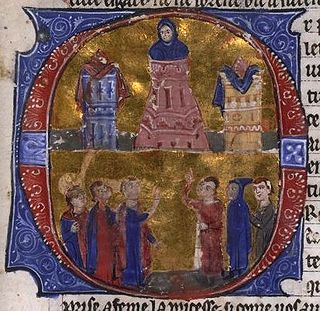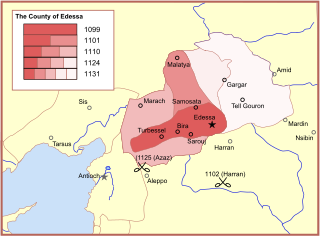
Baldwin I, also known as Baldwin of Boulogne, was the first count of Edessa from 1098 to 1100, and king of Jerusalem from 1100 to his death in 1118. He was the youngest son of Eustace II, Count of Boulogne, and Ida of Lorraine and married a Norman noblewoman, Godehilde of Tosny. He received the County of Verdun in 1096, but he soon joined the crusader army of his brother Godfrey of Bouillon and became one of the most successful commanders of the First Crusade.

Raynald of Châtillon, also known as Reynald or Reginald, was a Crusader knight of French origin but also Prince of Antioch from 1153 to 1160 or 1161, and Lord of Oultrejordain from 1175 until his death. He was born the second son of a French noble family. After losing a part of his patrimony, he joined the Second Crusade in 1147. He settled in the Kingdom of Jerusalem and served in the royal army as a mercenary.

Baldwin II, also known as Baldwin of Bourcq or Bourg, was Count of Edessa from 1100 to 1118, and King of Jerusalem from 1118 until his death. He accompanied his cousins Godfrey of Bouillon and Baldwin of Boulogne to the Holy Land during the First Crusade. He succeeded Baldwin of Boulogne as the second count of Edessa when he left the county for Jerusalem following his brother's death. He was captured at the Battle of Harran in 1104. He was held first by Sökmen of Mardin, then by Jikirmish of Mosul, and finally by Jawali Saqawa. During his captivity, Tancred, the Crusader ruler of the Principality of Antioch, and Tancred's cousin, Richard of Salerno, governed Edessa as Baldwin's regents.

The County of Edessa was one of the Crusader states in the 12th century. Its seat was the city of Edessa.

The Crusader States, also known as Outremer, were four Catholic realms in the Middle East that lasted from 1098 to 1291. These feudal polities were created by the Latin Catholic leaders of the First Crusade through conquest and political intrigue. The four states were the County of Edessa (1098–1150), the Principality of Antioch (1098–1287), the County of Tripoli (1102–1289), and the Kingdom of Jerusalem (1099–1291). The Kingdom of Jerusalem covered what is now Israel and Palestine, the West Bank, the Gaza Strip, and adjacent areas. The other northern states covered what are now Syria, south-eastern Turkey, and Lebanon. The description "Crusader states" can be misleading, as from 1130 very few of the Frankish population were crusaders. The term Outremer, used by medieval and modern writers as a synonym, is derived from the French for overseas.

Joscelin of Courtenay, Prince of Galilee and Lord of Turbessel (1115–1131) and Count of Edessa (1119–1131), ruled over the County of Edessa during its zenith, from 1118 to 1131. Captured twice, Joscelin continued to expand his county, even participating in the Battle of Azaz in 1125. Gravely injured during the collapse of a sapper mine, Joscelin marched his army to relieve the besieged fortress of Kaysun, and died soon after.

Leo I, also Levon I or Leon I, was the fifth lord of Armenian Cilicia or “Lord of the Mountains” (1129/1130-1137).
Thoros II, Prince of Armenia, also known as Toros II the Great or Thoros II the Great, was the sixth Lord of Armenian Cilicia from the Rubenid dynasty from 1144/1145–1169. Referred to as the “Lord of the Mountains”

Bohemond III of Antioch, also known as Bohemond the Child or the Stammerer, was Prince of Antioch from 1163 to 1201. He was the elder son of Constance of Antioch and her first husband, Raymond of Poitiers. Bohemond ascended to the throne after the Antiochene noblemen dethroned his mother with the assistance of the lord of Armenian Cilicia, Thoros II. He fell into captivity in the Battle of Harim in 1164, but the victorious Nur ad-Din, atabeg of Aleppo released him to avoid coming into conflict with the Byzantine Empire. Bohemond went to Constantinople to pay homage to Manuel I Komnenos, who persuaded him to install a Greek Orthodox patriarch in Antioch. The Latin patriarch of Antioch, Aimery of Limoges, placed Antioch under interdict. Bohemond restored Aimery only after the Greek patriarch died during an earthquake in 1170.
Toros I, also Thoros I, was the third lord of Armenian Cilicia or “Lord of the Mountains”.

The siege of Edessa took place from November 28 to December 24, 1144, resulting in the fall of the capital of the crusader County of Edessa to Zengi, the atabeg of Mosul and Aleppo. This event was the catalyst for the Second Crusade.
Matthew of Edessa was an Armenian historian in the 12th century from the city of Edessa. Matthew was the superior abbot of Karmir Vank', near the town of Kaysun, east of Marash (Germanicia), the former seat of Baldwin of Boulogne. He relates much about the Bagratuni Kingdom of Armenia, the early Crusades, and the battles between Byzantines and Arabs for the possession of parts of northern Syria and eastern Asia Minor. Byzantine authors such as Joannes Zonaras and Anna Comnena were well versed in their particular spheres, but uninformed regarding Edessa and neighboring lands which are treated by Matthew.
The Crusades were a series of religious wars initiated, supported, and sometimes directed by the Latin Church in the medieval period. The best known of these Crusades are those to the Holy Land in the period between 1095 and 1291 that were intended to recover Jerusalem and its surrounding area from Islamic rule. Beginning with the First Crusade, which resulted in the recovery of Jerusalem in 1099, dozens of Crusades were fought, providing a focal point of European history for centuries.
Gabriel of Melitene was the ruler of Melitene. Along with Thoros of Edessa, Gabriel was a former officer of Philaretos Brachamios. Philaretos had installed Gabriel as the ruler of Melitene. Following the death of Philaretos in 1086 Melitene became completely independent of Byzantine control with the aid of the Danishmends. Eventually the Danishmends began harassing Melitene. Gabriel appealed to Bohemund I of Antioch for assistance.

In the Battle of Melitene in 1100, a Crusader force led by Bohemond I of Antioch was defeated in Melitene in eastern Anatolia by Danishmend Turks commanded by Gazi Gümüshtigin.
Baldwin of Marash was a Crusader baron in Northern Syria.
Kogh Vasil, or Vasil the Robber, was the Armenian ruler of Raban and Kaisun at the time of the First Crusade. In the early 12th century, he was the most influential Armenian ruler who adhered to the Armenian Apostolic Church. He was succeeded by his adopted son, Vasil Dgha.
Vasil Dgha, or Dgha Vasil, was the Armenian ruler of Raban and Kaisun. He succeeded his adoptive father, Kogh Vasil, in 1112. Baldwin II, Count of Edessa, tortured Vasil to force him to abandon his domains in 1116. Vasil settled in Constantinople.
Basil bar Shumna was the Syriac Orthodox metropolitan archbishop of Edessa from 1143 until his death. He wrote a Syriac chronicle covering the years from 1118 until his death, which is now lost but was used as a source by Michael the Great and the anonymous author of the Chronicle of 1234.
The siege of Edessa in October–November 1146 marked the permanent end of the rule of the Frankish Counts of Edessa in the city on the eve of the Second Crusade. It was the second siege the city had suffered in as many years, the first siege of Edessa having ended in December 1144. In 1146, Joscelyn II of Edessa and Baldwin of Marash recaptured the city by stealth but could not take or even properly besiege the citadel. After a brief counter-siege, Zangid governor Nūr al-Dīn took the city. The population was massacred and the walls razed. This victory was pivotal in the rise of Nūr al-Dīn and the decline of the Christian city of Edessa.